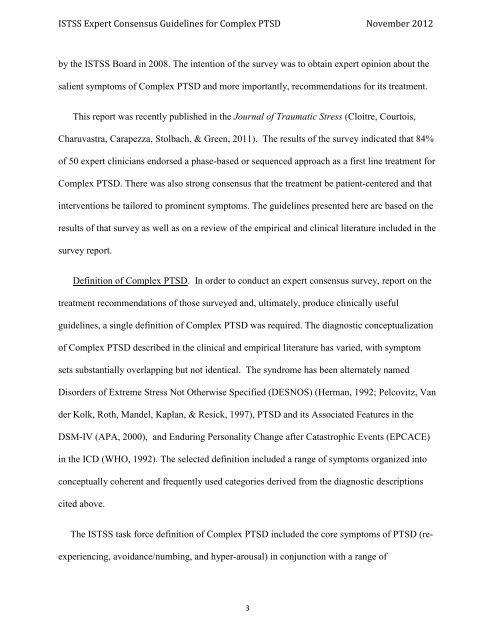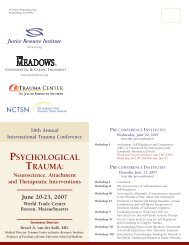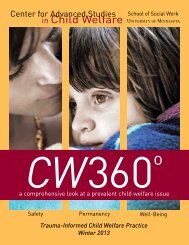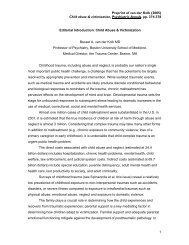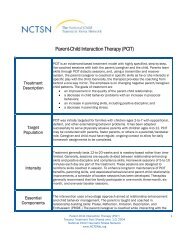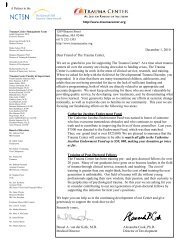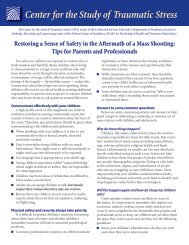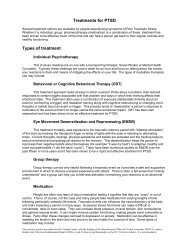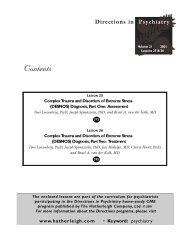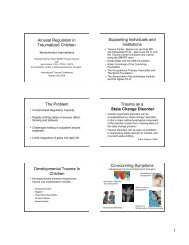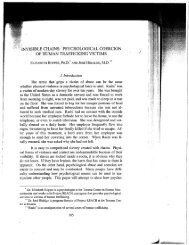ISTSS Expert Consensus Treatment Guidelines for Complex PTSD
ISTSS Expert Consensus Treatment Guidelines for Complex PTSD
ISTSS Expert Consensus Treatment Guidelines for Complex PTSD
You also want an ePaper? Increase the reach of your titles
YUMPU automatically turns print PDFs into web optimized ePapers that Google loves.
<strong>ISTSS</strong> <strong>Expert</strong> <strong>Consensus</strong> <strong>Guidelines</strong> <strong>for</strong> <strong>Complex</strong> <strong>PTSD</strong> November 2012<br />
by the <strong>ISTSS</strong> Board in 2008. The intention of the survey was to obtain expert opinion about the<br />
salient symptoms of <strong>Complex</strong> <strong>PTSD</strong> and more importantly, recommendations <strong>for</strong> its treatment.<br />
This report was recently published in the Journal of Traumatic Stress (Cloitre, Courtois,<br />
Charuvastra, Carapezza, Stolbach, & Green, 2011). The results of the survey indicated that 84%<br />
of 50 expert clinicians endorsed a phase-based or sequenced approach as a first line treatment <strong>for</strong><br />
<strong>Complex</strong> <strong>PTSD</strong>. There was also strong consensus that the treatment be patient-centered and that<br />
interventions be tailored to prominent symptoms. The guidelines presented here are based on the<br />
results of that survey as well as on a review of the empirical and clinical literature included in the<br />
survey report.<br />
Definition of <strong>Complex</strong> <strong>PTSD</strong>. In order to conduct an expert consensus survey, report on the<br />
treatment recommendations of those surveyed and, ultimately, produce clinically useful<br />
guidelines, a single definition of <strong>Complex</strong> <strong>PTSD</strong> was required. The diagnostic conceptualization<br />
of <strong>Complex</strong> <strong>PTSD</strong> described in the clinical and empirical literature has varied, with symptom<br />
sets substantially overlapping but not identical. The syndrome has been alternately named<br />
Disorders of Extreme Stress Not Otherwise Specified (DESNOS) (Herman, 1992; Pelcovitz, Van<br />
der Kolk, Roth, Mandel, Kaplan, & Resick, 1997), <strong>PTSD</strong> and its Associated Features in the<br />
DSM-IV (APA, 2000), and Enduring Personality Change after Catastrophic Events (EPCACE)<br />
in the ICD (WHO, 1992). The selected definition included a range of symptoms organized into<br />
conceptually coherent and frequently used categories derived from the diagnostic descriptions<br />
cited above.<br />
The <strong>ISTSS</strong> task <strong>for</strong>ce definition of <strong>Complex</strong> <strong>PTSD</strong> included the core symptoms of <strong>PTSD</strong> (reexperiencing,<br />
avoidance/numbing, and hyper-arousal) in conjunction with a range of<br />
3


